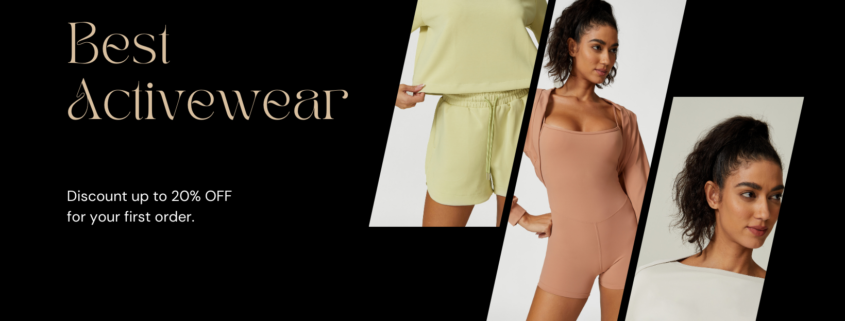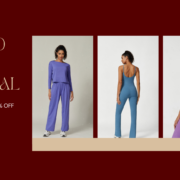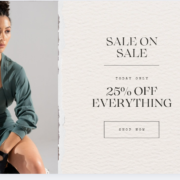How to Choose the Right Workout Clothes for Your Body
Choosing the right workout clothes for your body is essential for both comfort and performance. When selecting activewear, it’s important to consider factors like body shape, activity type, fabric, and fit to ensure you feel confident, supported, and able to move freely. Here’s a guide to help you choose the right workout clothes based on your body type and personal preferences:
1. Know Your Body Type
Understanding your body shape can help you choose clothes that highlight your strengths and provide the best fit. Here are some common body types and tips for each:
Hourglass Shape
- Features: Balanced proportions with a defined waist and curves.
- What to Wear: Opt for high-waisted leggings or shorts to accentuate your waist. Tops with a supportive structure or sports bras with good coverage and support will enhance your natural curves. Fitted or wrap-style tops can help define your waist while providing a flattering silhouette.
Pear Shape
- Features: Wider hips and thighs, with a narrower waist and shoulders.
- What to Wear: Look for tops that draw attention to the upper body, like bright colors or interesting patterns. A-line or flared workout pants can balance your proportions by creating a flattering fit around your hips and thighs. Compression leggings or high-waisted styles can help support the lower body.
Apple Shape
- Features: Broader shoulders, fuller midsection, and narrower hips.
- What to Wear: A fitted, high-waisted bottom can give structure and create a balanced silhouette. A-line or longer tops with an empire waist can provide more coverage and avoid drawing attention to the midsection. V-neck sports bras or tops with minimal seams will also elongate the upper body.
Rectangle Shape
- Features: Straight hips, waist, and shoulders with less defined curves.
- What to Wear: To create the illusion of curves, choose clothes with details like ruching, patterns, or color blocking. High-waisted leggings can help define the waist, and tops with a slight peplum or wrap-style fit can create the appearance of curves. Try fitted or sporty cuts that offer structure and shape.
2. Consider the Activity
Different types of workouts require different clothing choices to ensure comfort, flexibility, and support.
Yoga or Pilates
- Clothing to Choose: Stretchy, moisture-wicking fabrics like spandex, cotton blends, or bamboo. You’ll need flexibility for deep stretches, so choose leggings and tops that allow freedom of movement. High-rise leggings can provide extra coverage, while fitted tanks or long-sleeve shirts are great for comfort and support.
Running or High-Impact Activities
- Clothing to Choose: Compression or performance fabrics that wick away sweat. For added support, choose a supportive sports bra with good hold for high-impact activities. Running tights or shorts should have a secure waistband, and breathable materials like nylon or polyester are ideal.
Strength Training
- Clothing to Choose: Comfortable and durable fabrics that don’t restrict movement. Consider moisture-wicking tops and leggings with a good fit for freedom of movement. A fitted sports bra or supportive tank will give you the necessary support without restricting arm movement.
Cycling or HIIT
- Clothing to Choose: Choose form-fitting, stretchy fabrics that will allow you to move freely. Compression leggings or shorts that support muscles during movement can help reduce fatigue. Opt for tops with breathability and moisture-wicking qualities.
3. Prioritize Fit and Comfort
When shopping for workout clothes, fit is everything. The right fit will provide comfort, support, and freedom of movement during exercise. Here are some tips for a good fit:
- Leggings and Pants: They should fit snugly but not feel restrictive. Look for leggings that have a comfortable waistband that sits at your natural waist, with no pinching or rolling down. Compression leggings are ideal for support and muscle recovery, but they shouldn’t be too tight to cause discomfort.
- Tops and Sports Bras: Tops should fit comfortably without gaping or being too tight. Sports bras should offer enough support based on your activity level—higher-impact activities may require more coverage and stronger support, while lower-impact activities can get away with a lighter bra.
- Breathability: Fabrics should be breathable to allow air circulation and prevent overheating. Look for mesh inserts, moisture-wicking fabrics, or lightweight materials like cotton blends or merino wool that can help keep you cool and dry.
- Seamless Designs: Seamless workout clothes can prevent chafing, especially during long or high-intensity workouts. Look for leggings or sports bras that are designed without seams in high-friction areas.
4. Choose the Right Fabrics
The material of your workout clothes can greatly affect comfort, breathability, and performance. Here’s what to look for:
- Moisture-Wicking Fabrics: Polyester, nylon, and spandex blends are great choices as they wick away sweat and keep you dry. This is especially important during high-intensity workouts.
- Stretch Fabrics: Elastane or spandex blends are perfect for activities that require a lot of movement (e.g., yoga or pilates), as they provide flexibility and support.
- Breathable Natural Fibers: Cotton is comfortable, but it tends to retain moisture, so it’s better suited for low-impact activities or casual wear. Bamboo, merino wool, or Tencel are sustainable and breathable alternatives that also wick away moisture.
- Compression Fabrics: Compression wear helps improve circulation and muscle recovery. Look for items with a bit of spandex or elastane, such as compression leggings or sports bras, for added support.
5. Color and Style Preferences
While function is the priority, it’s also important to choose colors and styles that you feel good in and motivate you to work out. Bold colors, patterns, or neutral tones can affect how you feel about yourself during your workout. Pick colors that boost your confidence and align with your personal style.
- Neutral Tones: Black, grey, and navy are classic, easy-to-mix options that work well for all activities.
- Bold Colors: Bright hues like red, purple, or teal can give you an energy boost and help you stand out.
- Patterns: Go for patterns like stripes, geometric shapes, or tie-dye if you want a bit of personality or flair.
6. Test for Movement
Before committing to a workout outfit, do a quick test to ensure it provides full range of motion. Do a few stretches, squats, or lunges to check if the clothes restrict your movement or cause discomfort. If anything feels too tight, rides up, or pulls in certain areas, it’s not the right fit.
Final Tips:
- Comfort is Key: Your workout clothes should make you feel good and allow you to focus on your workout, not on adjusting your clothes.
- Invest in Versatility: Choose pieces that can be mixed and matched across different workouts and seasons.
- Don’t Forget About Layering: For outdoor workouts, layering items like lightweight jackets, sweatshirts, or vests can make a big difference in comfort.
By understanding your body type, considering your workout needs, and selecting fabrics that suit your activity, you’ll be able to choose the best workout clothes that make you feel confident, comfortable, and ready to move!







Leave a Reply
Want to join the discussion?Feel free to contribute!